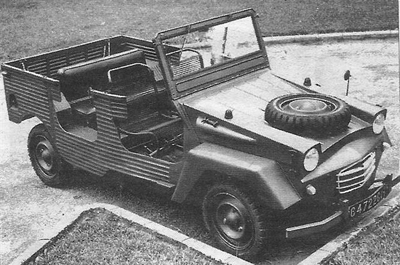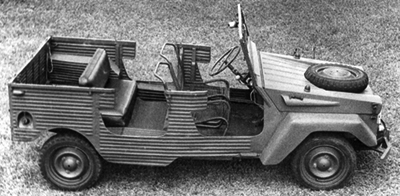|
Originally
conceived in 1963 by two Frenchmen, Mr. Letoquin and Mr. Lechanteur,who
were the owners of les Ateliers et Forges de l’Ebrié, a company in
Abidjan in the Côte d'Ivoire (Ivory Coast), the Baby Brousse was
originally based on the Ami 6
chassis and mechanical components but with a pressed steel body that
required no welding.
It can thus be seen as a sort of metal-bodied Méhari.
It is often suggested that the Méhari was inspired by the Baby Brousse
although the construction of the two vehicles is totally different.
Some 800 vehicles were produced "unofficially" while
negotiations continued with Citroën to put things on a more formal
basis.
In
1969, Citroën bought the licence for the Baby Brousse design from
Ateliers et Forges de l’Ebrié with a view to putting the design into
production in other countries. That same year, the Dalat
went into production in what was then South Vietnam. Whether there was
input from Citroën is not clear; indeed the fact that in 1973 Citroën
brought three Dalat bodies to
France from Vietnam and analysed the design would suggest not. From
these studies they designed a vehicle whose simple manufacture could be
carried out without requiring heavy investments in pressing tools and
used the Baby Brousse name originally used in Côte d'Ivoire.
Additionally,
Dalat proposed a 4x4 version of the car but Citroën were not
interested. The sole example was sent to Citroën for study.
The later Baby Brousse was based on the mechanical
underpinnings of the 2CV Fourgonnette
and it was intended that the mechanical components would be exported
from France as CKD (completely knocked down) kits for assembly in
countries without the industrial infrastructure to build automobiles.
It was thus quite similar in concept to the FAF
and Africar.
The bodywork was made of pressed steel, required no
welding
and was bolted to the chassis.
Because
of the artisanal nature of the vehicle's construction and problems with
obtaining components, a number of modifications were frequently made
locally which resulted in changes in appearance.
In 1977,
Citroën signed a framework agreement with Guinée Bissau to produce 500
vehicles (whether Baby Brousse or FAF is not known) per year and in
1979, Citroën entered into agreements for the manufacture of the FAF in
Sénégal, Côte d'Ivoire, Guinée Bissau and République Centrafricaine.
|
 |
Baby Brousse or FAF?
The
FAF design drew strongly on the Baby Brousse but differed in two major
respects - it had a roof (although the Patrol was open-topped) and the body comprised
spot welded panels which were bolted together.
|
|
|
|
Or does the story start
even earlier?
|
 |
|
Towards
the end of the nineteen fifties in Abidjan in the Côte d'Ivoire a
French expatriate named Maurice Delignon who found himself in Côte
d'Ivoire at the end of the Second World War proposed what might be seen
as the ancestor of the Baby Brousse.
By
trade a cabinet maker, he was an inventor at heart and also designed
and built a submarine which for years was moored in Abidjan where it
was used as a restaurant. Delignon took it with him when he returned to
France in the mid nineteen eighties and it was moored at the foot of
the Eiffel Tower in Paris and was then moved in the early nineties to a
mooring between the pont de Puteaux and the pont de Suresnes.
|

|
|
The car design was viewed as
"eccentric"
and was not put into production.
The
idea was revived several years later by Messrs Letoquin and Lechanteur
and the Baby Brousse was born. It is not known whether they were aware
of Delignon's proposal but geography and being members of the same
expatriate community would suggest that they were.
|
|
|
| Côte d'Ivoire |
With the agreement of Citroën, manufacture started in
the Ivory Coast in 1970 and the Baby Brousse
quickly acquired a reputation for being both robust and economical. The
Baby Brousse provided four seats in a body without doors and a folding
windscreen. It can be recognised by its trapezoidal air intake.
Citroën's records indicate that 1,320 cars were built.
|
 |
 |
|
| Vietnam |
SAEO
(the Vietnamese subsidiary of Citroën), decided in 1969, in view of the
success of the 2CV vans that had been imported, to build a vehicle
equipped with a pressed steel body, using the 2CV
chassis and engine. The Dalat
was very similar in concept to the Baby Brousse and can be recognised
by its square grille and Dyane headlights. It was available as an
ambulance, taxi-bus and police car in addition to the regular
"metal-bodied Méhari" body style. It is believed that more than 5,000
examples were built between 1970 and the fall of Saigon in 1975
although Citroën's records indicate that the number was 2,895 with 30
being built in 1985.
|
 |
 |
|
| Iran |
The Baby Brousse (called Jiane Mehari) was built by Saipa
who had previously assembled 2CVs. The car was built alongside various Dyane
variants from 1970 to 1979. Citroën's records indicate that 9,315 were
built between 1970 and 1976.
|
 |
 |
|
| Sénégal |
The Baby Brousse (called Méhari)
was built by Etablissements Marchand from 1979 to 1983 and it can be
recognised by its "jeep" grille. It is believed that about 500 examples
were built although Citroën's records indicate that the number was 60
with 15 FAFs.
|
 |
 |
|
| Chile |
In Chile, alongside local variants of the 2CV
a version of the Baby Brousse called Yagán was built. It was
built between 1972 and 1976. 651 examples.
|
 |
 |
|
| Greece |
Namco, the Greek Citroën concessionaire assembled a
vehicle called Pony in a factory
constructed specifically for the purpose in Thessalonika. This vehicle
is probably closer to the FAF (although
it pre-dates that design) than it is to the Baby Brousse and was
available as both an open top version and a roofed one. The Pony used the
mechanical components of the Dyane 6
and was better built and equipped than the other similar vehicles and a
wider range was marketed. They were exported to Switzerland,
Liechtenstein, Austria, Tunisia, Egypt and Germany. Some 17,000
examples were built.
|
 |
 |
|
| Guinea
Bissau |
In addition to the FAF,
a number of Baby Brousse cars were built in Guinée Bissau. It is
rumoured that these vehicles, including a hypothetical 4x4 were used by
the Portuguese Army in Angola. It is possible however, that the
military vehicles used in Angola were constructed in the Citroën
factory in Portugal.
|
 |
 |
|
| Indonesia |
480 Baby Brousses were built in Indonesia between 1982
and 1987 and 630 FAFs were built in
1979 and 1980.
|
 |
 |
|
| Central African
Republic/République Centre Africaine |
180 Baby Brousses were built in the Central African
Republic in 1982 and 1983 and 60 FAFs
were built in 1980.
|
 |
 |
|
|
Official production figures - it should
be noted that these are probably not very accurate...
|
|
BABY BROUSSE
|
1970
|
1971
|
1972
|
1973
|
1974
|
1975
|
1976
|
1977
|
1978
|
1979
|
1980
|
1981
|
1982
|
1983
|
1984
|
1985
|
1986
|
1987
|
|
|
Greece
|

|

|

|

|
30
|
120
|
450
|
1,620
|
3,330
|
4,710
|
2,880
|
2,040
|
1,020
|
480
|

|

|

|

|
16,680
|
|
Côte d'Ivoire
|
45
|
45
|
90
|

|
180
|
420
|
300
|
210
|
30
|

|

|

|

|

|

|

|

|

|
1,320
|
|
Guinea Buissau
|

|

|

|

|

|

|

|

|

|

|

|

|
120
|

|

|

|

|

|
120
|
|
République Centre Africaine
|

|

|

|

|

|

|

|

|

|

|
60
|
60
|
60
|

|

|

|

|

|
180
|
|
Sénégal
|

|

|

|

|

|

|

|

|

|

|

|

|
30
|
30
|

|

|

|

|
60
|
|
Indonesia
|

|

|

|

|

|

|

|

|

|

|

|

|
360
|
90
|

|

|

|
30
|
480
|
|
Iran
|
585
|

|
1,485
|
1,125
|
2,070
|
3,510
|
540
|

|

|

|

|

|

|

|

|

|

|

|
9,315
|
|
Vietnam
|
30
|
2,385
|
450
|

|

|

|

|

|

|

|

|

|

|

|

|
|

|

|
2,895
|
|

|
660
|
2,430
|
2,025
|
1,125
|
2,280
|
4,050
|
1,290
|
1,830
|
3,360
|
4,710
|
2,940
|
2,100
|
1,590
|
600
|

|
30
|

|
30
|
31,050
|
|
FAF
|
1970
|
1971
|
1972
|
1973
|
1974
|
1975
|
1976
|
1977
|
1978
|
1979
|
1980
|
1981
|
1982
|
1983
|
1984
|
1985
|
1986
|
1987
|
|
|
Portugal
|

|

|

|

|

|

|

|
180
|
30
|
180
|
240
|
180
|

|

|

|

|

|

|
810
|
|
Guinea Buissau
|

|

|

|

|

|

|

|

|

|
120
|
180
|

|

|

|

|

|

|

|
300
|
|
République Centre Africaine
|

|

|

|

|

|

|

|

|

|

|
60
|

|

|

|

|

|

|

|
60
|
|
Sénégal
|

|

|

|

|

|

|

|

|

|

|

|
15
|

|

|

|

|

|

|
15
|
|
Indonesia
|

|

|

|

|

|

|

|

|

|
60
|
540
|

|

|

|

|

|

|

|
600
|
|

|

|

|

|

|

|

|

|
180
|
30
|
360
|
1,020
|
195
|

|

|

|

|

|

|
1,785
|
|
|